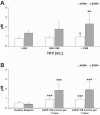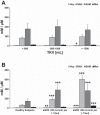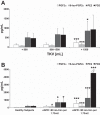Endothelial dysfunction and oxidative stress in polycystic kidney disease
- PMID: 25234311
- PMCID: PMC4254971
- DOI: 10.1152/ajprenal.00327.2014
Endothelial dysfunction and oxidative stress in polycystic kidney disease
Abstract
Cardiovascular disease (CVD) is the leading cause of premature mortality in ADPKD patients. The aim was to identify potential serum biomarkers associated with the severity of ADPKD. Serum samples from a homogenous group of 61 HALT study A ADPKD patients [early disease group with estimated glomerular filtration rate (eGFR) >60 ml·min(-1)·1.73 m(-2)] were compared with samples from 49 patients from the HALT study B group with moderately advanced disease (eGFR 25-60 ml·min(-1)·1.73 m(-2)). Targeted tandem-mass spectrometry analysis of markers of endothelial dysfunction and oxidative stress was performed and correlated with eGFR and total kidney volume normalized to the body surface area (TKV/BSA). ADPKD patients with eGFR >60 ml·min(-1)·1.73 m(-2) showed higher levels of CVD risk markers asymmetric and symmetric dimethylarginine (ADMA and SDMA), homocysteine, and S-adenosylhomocysteine (SAH) compared with the healthy controls. Upon adjustments for age, sex, systolic blood pressure, and creatinine, SDMA, homocysteine, and SAH remained negatively correlated with eGFR. Resulting cellular methylation power [S-adenosylmethionine (SAM)/SAH ratio] correlated with the reduction of renal function and increase in TKV. Concentrations of prostaglandins (PGs), including oxidative stress marker 8-isoprostane, as well as PGF2α, PGD₂, and PGE₂, were markedly elevated in patients with ADPKD compared with healthy controls. Upon adjustments for age, sex, systolic blood pressure, and creatinine, increased PGD₂ and PGF₂α were associated with reduced eGFR, whereas 8-isoprostane and again PGF₂α were associated with an increase in TKV/BSA. Endothelial dysfunction and oxidative stress are evident early in ADPKD patients, even in those with preserved kidney function. The identified pathways may provide potential therapeutic targets for slowing down the disease progression.
Keywords: ADPKD; NO pathway; biomarkers; endothelial dysfunction; oxidative stress.
Copyright © 2014 the American Physiological Society.
Figures




Similar articles
-
Elevated asymmetric dimethylarginine is associated with oxidant stress aggravation in patients with early stage autosomal dominant polycystic kidney disease.Kidney Blood Press Res. 2013;38(1):72-82. doi: 10.1159/000355756. Epub 2014 Feb 18. Kidney Blood Press Res. 2013. PMID: 24577239
-
Bioactive lipid mediators in polycystic kidney disease.J Lipid Res. 2014 Jun;55(6):1139-49. doi: 10.1194/jlr.P042176. Epub 2013 Dec 16. J Lipid Res. 2014. PMID: 24343898 Free PMC article. Clinical Trial.
-
Inflammation, oxidative stress, and insulin resistance in polycystic kidney disease.Clin J Am Soc Nephrol. 2011 Jan;6(1):7-13. doi: 10.2215/CJN.04140510. Epub 2010 Sep 9. Clin J Am Soc Nephrol. 2011. PMID: 20829421 Free PMC article.
-
Predictors of rapid disease progression in autosomal dominant polycystic kidney disease.Minerva Med. 2017 Feb;108(1):43-56. doi: 10.23736/S0026-4806.16.04830-8. Epub 2016 Oct 4. Minerva Med. 2017. PMID: 27701376 Review.
-
Assessing Risk of Rapid Progression in Autosomal Dominant Polycystic Kidney Disease and Special Considerations for Disease-Modifying Therapy.Am J Kidney Dis. 2021 Aug;78(2):282-292. doi: 10.1053/j.ajkd.2020.12.020. Epub 2021 Mar 8. Am J Kidney Dis. 2021. PMID: 33705818 Review.
Cited by
-
Reprogramming of Energy Metabolism in Human PKD1 Polycystic Kidney Disease: A Systems Biology Analysis.Int J Mol Sci. 2024 Jun 29;25(13):7173. doi: 10.3390/ijms25137173. Int J Mol Sci. 2024. PMID: 39000280 Free PMC article.
-
Endothelial Dysfunction and Atherosclerosis in Patients With Autosomal Dominant Polycystic Kidney Disease.Cureus. 2021 Feb 25;13(2):e13561. doi: 10.7759/cureus.13561. Cureus. 2021. PMID: 33815976 Free PMC article.
-
Interactions between Macrophages and Cyst-Lining Epithelial Cells Promote Kidney Cyst Growth in Pkd1-Deficient Mice.J Am Soc Nephrol. 2018 Sep;29(9):2310-2325. doi: 10.1681/ASN.2018010074. Epub 2018 Jul 24. J Am Soc Nephrol. 2018. PMID: 30042193 Free PMC article.
-
Nephron-Specific Disruption of Polycystin-1 Induces Cyclooxygenase-2-Mediated Blood Pressure Reduction Independent of Cystogenesis.J Am Soc Nephrol. 2020 Jun;31(6):1243-1254. doi: 10.1681/ASN.2019090934. Epub 2020 Apr 16. J Am Soc Nephrol. 2020. PMID: 32300065 Free PMC article.
-
Renal hemodynamic effects of the HMG-CoA reductase inhibitors in autosomal dominant polycystic kidney disease.Nephrol Dial Transplant. 2016 Aug;31(8):1290-5. doi: 10.1093/ndt/gfv394. Epub 2015 Nov 27. Nephrol Dial Transplant. 2016. PMID: 26614268 Free PMC article. Clinical Trial.
References
-
- Banerjee RV, Matthews RG. Cobalamin-dependent methionine synthase. FASEB J 4: 1450–1459, 1990. - PubMed
-
- Beltowski J, Kedra A. Asymmetric dimethylarginine (ADMA) as a target for pharmacotherapy. Pharmacol Rep 58: 159–178, 2006. - PubMed
-
- Breyer MD, Breyer RM. G protein-coupled prostanoid receptors and the kidney. Annu Rev Physiol 63: 579–605, 2001. - PubMed
Publication types
MeSH terms
Substances
Grants and funding
LinkOut - more resources
Full Text Sources
Other Literature Sources
Research Materials
Miscellaneous

